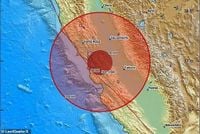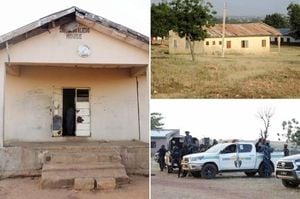On Tuesday morning, California’s Central Coast was rocked by a magnitude 4.1 earthquake, sending shockwaves along the coastline and rattling nerves from Salinas in the north to Lompoc in the south. The tremor, which struck near Templeton at 9:45 AM Pacific Time, was felt by hundreds of residents, many of whom quickly reported their experiences to the United States Geological Survey (USGS). According to the USGS, over 600 people had submitted reports within hours, describing the quake as a moderate jolt that could have shattered windows or toppled unstable objects.
While earthquakes are no stranger to Californians, the timing and location of this event immediately raised concerns. Templeton sits close to the notorious San Andreas Fault, a tectonic boundary infamous for its potential to unleash devastating quakes. The USGS wasted no time in addressing public fears, confirming there was “No Tsunami Warning, Advisory, Watch, or Threat” issued for the region. Even officials as far north as British Columbia, Canada, informed citizens that there was no tsunami threat to their coastline.
The quake’s impact was measured as “MMI V” on the USGS’s ShakeMap, indicating a level of shaking that is noticeable and could cause minor damage. While most residents experienced only a brief scare, the event served as a stark reminder of California’s seismic vulnerability. Data from the USGS shows that California is the third most seismically active state in the U.S., trailing only Hawaii and Alaska. So far in 2025, the state has already recorded over 14,000 tremors—an astounding figure, but one that reflects both the state’s restless geology and its dense population centers, which make even moderate quakes more likely to be felt and reported.
Experts have long warned that California sits on borrowed time. The San Andreas Fault, stretching roughly 800 miles through the state, is capable of producing earthquakes up to magnitude 8.2. “The San Andreas Fault can generate the region’s largest magnitude earthquakes (up to about M8.2),” the USGS notes. The last truly massive quake on this fault was the M7.9 Fort Tejon earthquake of 1857, which was felt as far away as Los Angeles. Since then, more than 167 years have passed—longer than the typical 150-year interval between major events suggested by historical trends.
Angie Lux, a project scientist for Earthquake Early Warning at the Berkeley Seismology Lab, previously told the Daily Mail, “Experts are fairly confident that there could be a pretty large earthquake at some point in the next 30 years.” This so-called “Big One” is predicted to cause catastrophic damage: an estimated 1,800 deaths, 50,000 injuries, and $200 billion in losses, according to projections from the Great California Shakeout. The sheer scale of potential devastation makes every tremor a cause for concern, even when—like this week’s quake—it turns out to be relatively minor.
Adding to the anxiety, the USGS warned that there is a 21 percent chance of another magnitude 3 or higher earthquake in California within the next week, and a 3 percent chance of a magnitude 4 or higher event in the same period. These odds, while not overwhelming, underscore the perpetual risk that residents live with. “Southern California is also home to small areas of volcanic and geothermal activity, including Coso, north of Ridgecrest, and in the area south of the Salton Sea,” the USGS pointed out. In these regions, hot fluids or magma moving through the Earth’s crust can trigger local stresses and fracture movements, leading to what scientists call seismic swarms—clusters of earthquakes that might last hours, days, or even years, with no clear mainshock.
California’s quake was not an isolated event. In the 24 hours between November 18 and 19, 2025, the USGS recorded a total of 515 earthquakes worldwide, five of which measured magnitude 5 or higher. According to USGS data, major quakes were detected in diverse regions, including areas between Costa Rica’s Pacific offshore and the northern coastline of Japan, as well as the Caribbean Sea. Other notable events included a magnitude 4.9 near San Antonio de los Cobres in Argentina, a 4.8 at the West Chile Rise, and a 4.7 south of Fiji. In all, the global seismic activity released an estimated 3.5 × 1013 joules of energy—equivalent to about 9.61 gigawatt-hours or 8,267 tons of TNT, roughly half the energy of a small atomic bomb.
While none of these recent global events reached magnitude 6 or higher, the cumulative activity reveals a planet in constant motion. For travelers, this reality brings both practical and philosophical considerations. As reported by the USGS Earthquake Hazards Program, regions that experience frequent magnitude 5 events may still be safe for tourism, provided that local infrastructure is resilient and emergency response systems are robust. Travelers are advised to familiarize themselves with evacuation routes and to choose accommodations that adhere to strict safety standards. As the USGS notes, “awareness pays dividends.”
The travel industry, too, must adapt to this ever-present risk. Stakeholders and destination marketers are increasingly called upon to highlight not just the beauty and excitement of their locales, but also the measures in place to ensure visitor safety. The knowledge that “the world beneath our feet never sleeps” fosters a sense of humility and respect, both for the natural forces at work and for the human ingenuity that strives to mitigate their impact.
For most people, the faint rumble of an earthquake remains a distant possibility—a curiosity rather than a crisis. But for those living in or traveling to seismically active areas like California, vigilance and preparedness are part of daily life. The events of this week serve as a timely reminder: while we can’t predict exactly when the next big quake will strike, we can take steps to be ready when it does.
As the ground settles once more along California’s Central Coast and seismic monitors continue their ceaseless watch around the globe, the message is clear: resilience, awareness, and informed choices remain our best defense against the unpredictable power of the planet beneath us.





